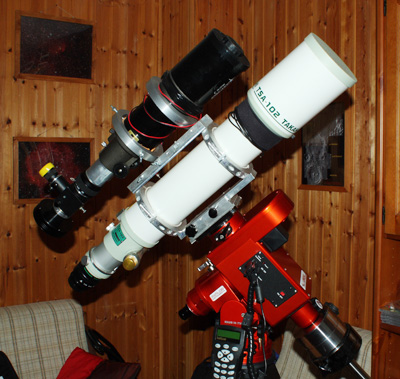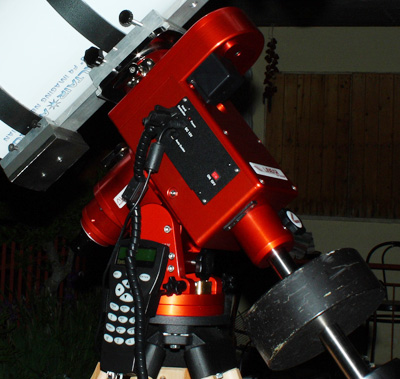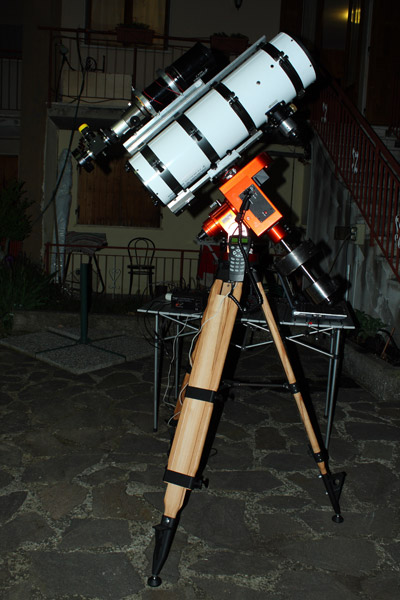LINEAR EQUATORIAL MOUNT
|
|
The LineAr mount by Avalon Instruments is a german equatorial mount
very light which has a good payload and high precision. It was created for a expert astrophotographer as the manufacturer made it to make esier to take photos of the sky. It is a very light and compact mount but it's also very strenght and you can load heavy and long focal instruments till 11" SC I tested it with a 8" newtonian telescope at f/8 /with a barlow 2x) and guide scope on piggyback. As I modded my telescope the weight was more than 45 lbs but the mount worked very well without problem and it's use was very easy. The mount use the well known Skyscan from Skywatcher. This Goto System is very easy to use and to learn and periodically the manufacturer upgrades its firmware to improve further utility and to fix any bug. The package is very compact (all the components, except the tripod, are placed in the case) and very well padded with foam. The counterweight bar diameter is certainly generous and fair for the load that it should be submitted. It's possible to remove the bar loosening a knob. The motors are placed inside the carter sucs as the wire so the mount is very clean and fine. The few cables that come from the mount are: The cable for paddle (in my opinion it is too short), the power supply, the autoguider connection LX200 standard (not to be confused with the Sbig St4 protocol that has a slightly different pinout). The connecting protocol to pc is Celestron Nexstar GPS (the same of all the mounts that use the Skyscan). The mount has the classic Losmandy pier but it's possible to have the Vixen one. |
|
 |
 |
|
I tested the mount with the newtonian telescope above described with a Takahashi TSA 102-S apochromatic refractor and with a Schmidt Cassegrain Celestron C9.25 HD reduced at f/7.3 using an Off Axis Guide, while the other two telescopes had a guide scope 4" f/5 on piggyback. To take the picture with the newton and the apo I used a Baader filter modified Canon Eos 40D (the guide camera was an Atik 16IC) while the pictures with the SC were taken using a unmodified Canon Eos 1000D and, as guide camera, a Magzero MZ5-M. The first impression wasn't good because I felt elastic movements as I pressed on one side of the telescope. This impression was due to the fact that the mount doesn't have the classic gear reductions sistem but uses a pulley and a belt to move the axis so there is a little residue of elasticity. But there are no clearances and there is immediately response to any movement. Unfortunately this elasticity can disturb visual because during focusing our hands tremor cause little vibrations. If we have a motofocuser or a micrometric one we have no disturb. I tried to focus with the SC C9,25 and the disturb was clear while I have no problem to focus with newton telescope plus barlow (almost same focal lenght of SC with reducer) which has a Baader Steel track focuser. I don't speak about assemblying of the mount (very, very easy) as polar allignment (the polar scope is the same of Skywatcher mounts). I saw a couple of improvements for further version of this mounts: a red light for the polar scope and a caps to protect the eyepiece of solar scope itself. I hope the manufacturer'll improve them as soon as possible. Another useful "gadget" (not in this photos but immediately done) is a handle to transport easily the mount. In spite of the elasticity of the belts and thank to the Baader tripod I had with the mount the damping was reasonable and I found no vibrations or fluctuations. |
|
|
The polar alignment is very fast and easy. The mount has a spheric level to put it in plane. Regulation in azimuth is possible through two knob (push-pull) and a pawl. The movement in altitude through other two knobs. The front one to block the movement and the back to pull up or down the polar axis. In the mount I tested I found a limited range in altitude (about from 30° to 55°) but for Europe and Usa it's enough. I'm sure that the manufacturer will allow to use in different range of latitude his mount. In the test I done with my newton and my Tsa 102 I used the default setting of the Skyscan, as a beginner. The guide setting was 0.5x. I used a guide scope of a focal lenght of 500 mm (20") and as guide camera my Atik 16 IC (pixel size 7.4 * 7.4 microns) for a scale of almost 3"/pixel. The focal lenght of the scopes I used for the tests were 1600 mm (64"), 800 mm (32") and 640 mm (25 1/5"). The camera was a canon eos 40D modified (pixel size 5.7 * 5.7 microns) for a scale respectively of 0.75"/pixel, 1.5"/pixel and 1.8"/pixel. Unfortunately some troubles with mu guidescope caused few flexures so the results were compromised. As I removed from data the flexure I noticed that the guide seemed to be too aggressive, with rebounds, due to overcorrections. The test with C9.25 at f/7.3 using a Canon Eos 1000D guiding with an OAG an a Magzero MZ5-M had a guide speed set at 0.125x and high frame rate. As I modified the guide speed the mount had a almost perfect guide also with higher focal lenght and the guide graph was almost straight. This fact depends from the pulley and belt movements, faster and faster than the gear reduction sistem. My advice is to set the guide speed the lower is possible to have a very good guiding. |
 |
|
Few words about balancing. In my humble opinion, using this mount, balancing must be even more accurate than in mounts with different transmission because of the less mechanical inertia. Once loosened the clutches, you can easy balance the mount in right ascension but in declination the mount has a minor fluidity of movement. This problem has been reported to the manufacturer and when I wrote this test it was already resolved. In conclusion, the test of the mount was positive and this is a mount easy transportable, snall size, robust and precise. In my opinion its range of use is with telescope of focal range no more than 4 feet and total weight not exceeding 35 lbs this is usually the setup of most astrophotographers. Infact using this setup the number of good shoots is close to 100% (obviously if the other parts of the setup are in perfect order). If you exceed focal lenght or weight (or both) there always is a risk of external disturbances (such as wind or ground vibration) that may reduce the number of correct pictures. Furthermore with higher focal lenght I advice to use an off axis guide, to reduce weight, differential bending and to minimize the surface area exposed to the wind. Obviously in the experience of the astrophotographer is high the use even with high focal lenght is not impossible, indeed!! At last I wish to tell something about finishes and aesthetics. There are not critical to use any mount but it's beatiful to see a mount like this. Well finished in every detail. aluminium is well anodized with a red color like the Ferrari racing cars. The manufacturer took care about every details, even from the aesthetic point of view. It's seems to me a product made from the heart and not thinking about the wallet. It's not the cheaper mount in its range but it has nothing to do with mass construction from China and also about similar products from Europe, America or Japan it has an excellent quality/price ratio. |
|
|
© 2011 may - Renzo Del Rosso |
|
Update: After writing this test I was able to verify the appropriate deployments on the mount that guarantees use even easier. In fact, the clutch has actually been improved and the fluidity of use has taken advantage so that now it is easier to guide even with a long focal length although it is always preferable, with focal length greater than 4/5 feet to use an off-axis guide to have aimproved accuracy and a lower load. The mount, now, has a more accurate level for an easier pointing to the pole. The manufacturer has shown great receptivityto the advices of users so I will notbe surprised if further improvements were implemented, although already the product shows extreme care and precision. |
|
© 2012 february - Renzo Del Rosso |
|
Did you find this article useful? Help me to keep online the web-site A web-site has some costs, both in time consuming as well as in hosting and domain maintenance. If you wish, you can give a donation of any amount. |